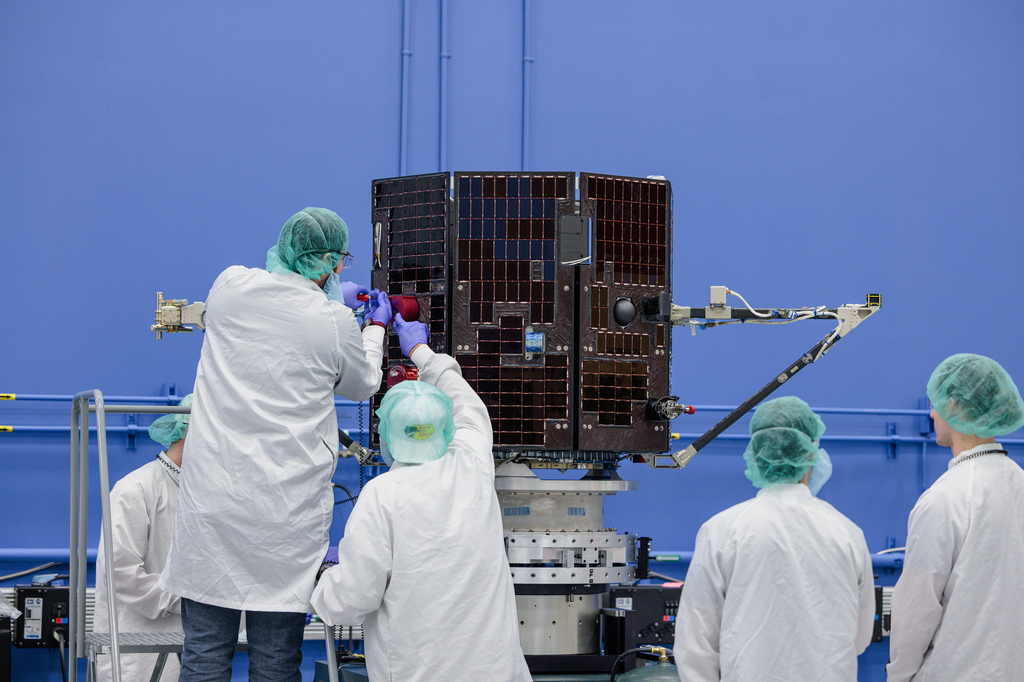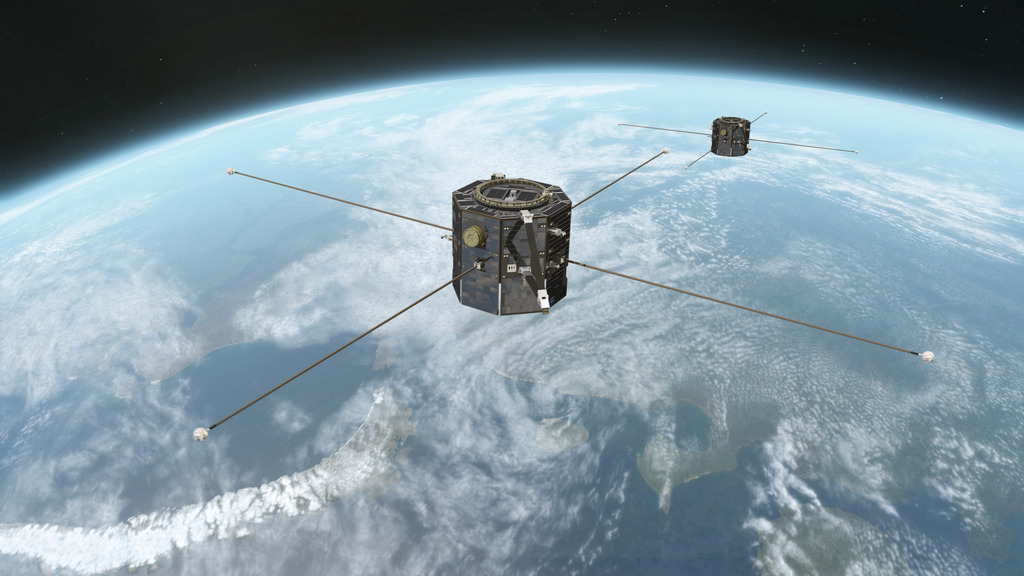TRACERS Instrument Development & Testing at the University of Iowa
NASA’s Tandem Reconnection and Cusp Electrodynamics Reconnaissance Satellites, or TRACERS, is embarking on its integration and testing campaign, during which all of the instruments and components will be added to the spacecraft structure, tested to ensure they will survive the harsh environments of launch and space, and made ready to execute its mission.
The TRACERS mission will help scientists understand an explosive process called magnetic reconnection and its effects in Earth’s atmosphere. Magnetic reconnection occurs when magnetic fields and particles from the Sun interact with Earth’s magnetic field. By understanding this process, scientists will be able to better understand and prepare for impacts of solar activity on Earth, such as auroras and disruptions to telecommunications.
Below are clips of TRACERS’ instrument design, build, and testing at the University of Iowa in Iowa City, Iowa.
Learn more about the mission: https://science.nasa.gov/mission/tracers/
B-Roll: TRACERS scientists conduct final testing on all six of the mission’s instruments during a three week period at Van Allen Hall on the University of Iowa campus. For the testing, each instrument was placed in a clean room, where headsets allowed a team of scientists in an adjoining room to direct testing operations according to an extensive checklist.
Credit: University of Iowa / David Scrivner
B-Roll: Magnetometer brackets – which will act as the structural components that connect TRACERS’ Fluxgate Magnetometer (MAG) and Magnetic Search Coil (MSC) instruments to the spacecraft – are fabricated in the physics and astronomy machine shop on the University of Iowa campus.
Credit: University of Iowa / David Scrivner

Photo: TRACERS’ main electronics box will act as the communications center for the spacecraft’s six onboard instruments. Embedded in the box is a purple guitar pick, a tribute to former TRACERS principal investigator and musician, Craig Kletzing, who died in August 2023.
Credit: University of Iowa / Tim Schoon

Photo: David Sheets, TRACERS research engineer and systems engineer for the Analyzer for Cusp Electrons (ACE) instrument, conducts electromagnetic interference tests for TRACERS’ main electronics box – the communications center for all six of the mission’s instruments – in Van Allen Hall at the University of Iowa.
Credit: University of Iowa / Tim Schoon

Photo: Jasper Halekas, lead for the Analyzer for Cusp Electrons (ACE) instrument, gestures to a chamber used for the final calibration tests that will ensure ACE will make accurate measurements in Van Allen Hall at the University of Iowa.
Credit: University of Iowa / Tim Schoon

Photo: “Flat Sat,” a full-scale mockup of the TRACERS spacecraft, is used by TRACERS scientists at the University of Iowa to help precisely arrange the instruments onboard the spacecraft.
Credit: University of Iowa / Tim Schoon

Photo: “Flat Sat,” a full-scale mockup of the TRACERS spacecraft, is used by TRACERS scientists at the University of Iowa to help precisely arrange the instruments onboard the spacecraft.
Credit: University of Iowa / Tim Schoon

Photo: Rich Dvorsky, project systems engineer for TRACERS, prepares the MAGnetometers for Innovation and Capability (MAGIC) instrument for vibration testing – which verifies they can withstand the rigors of spaceflight – in Van Allen Hall at the University of Iowa.
Credit: University of Iowa / Tim Schoon

Photo: The MAGnetometers for Innovation and Capability (MAGIC) instrument – a demonstration magnetic field instrument – is prepared for vibration testing that will verify they can withstand the rigors of spaceflight in Van Allen Hall at the University of Iowa.
Credit: University of Iowa / Tim Schoon

Photo: Greyson Davis (left), post-doctoral researcher at the University of Iowa, and Andrew Carton (right), TRACERS aerospace engineer, monitor electromagnetic testing of the TRACERS instrument suite in the EMI/EMC test center at Van Allen Hall at the University of Iowa.
Credit: University of Iowa / Tim Schoon

Photo: The Magnetic Search Coil (MSC) instrument is prepared for vibration testing – which will verify they can withstand the rigors of spaceflight – at Van Allen Hall at the University of Iowa.
Credit: University of Iowa / Tim Schoon

Photo: The Magnetic Search Coil (MSC) instrument is prepared for vibration testing – which will verify they can withstand the rigors of spaceflight – at Van Allen Hall at the University of Iowa.
Credit: University of Iowa / Tim Schoon

Photo: Sam Hisel, an aerospace design engineer, performs testing on a sensor for the MAGnetometers for Innovation and Capability (MAGIC) instrument, a demonstration magnetic field instrument that will fly as part of the TRACERS mission.
Credit: University of Iowa / Tim Schoon

Photo: Andrew Carton, TRACERS aerospace engineer, conducts final tests on the TRACERS instruments while they’re bolted onto the mock spacecraft “Flat Sat” in a clean room at Van Allen Hall at the University of Iowa, before the instrument suite was packed and shipped to Millennium Space Systems in California.
Credit: University of Iowa / Tim Schoon

Photo: Garret Hinson (left), quality assurance manager for TRACERS, Kate Morris (center), mechanical engineer for TRACERS, and Andrew Carton (right), TRACERS aerospace engineer, conduct final tests on the TRACERS instruments while they’re bolted onto the mock spacecraft “Flat Sat” in a clean room at Van Allen Hall at the University of Iowa, before the instrument suite was packed and shipped to Millennium Space Systems in California.
Credit: University of Iowa / Tim Schoon

Photo: Final tests are conducted on the TRACERS instruments while they’re bolted onto the mock spacecraft “Flat Sat” in a clean room at Van Allen Hall at the University of Iowa, before the instrument suite was packed and shipped to Millennium Space Systems in California.
Credit: University of Iowa / Tim Schoon

Photo: The Analyzer for Cusp Electrons (ACE) instrument, housed in Mylar – a protective polyester film – is readied for the vibration table – which simulates the instrument’s ability to withstand the rigors of spaceflight – at Van Allen Hall at the University of Iowa.
Credit: University of Iowa / Tim Schoon

Photo: Jasper Halekas, Analyzer for Cusp Electrons (ACE) instrument lead, checks data during final calibration testing – which took place in the chamber on the left – for the ACE instrument at Van Allen Hall at the University of Iowa.
Credit: University of Iowa / Tim Schoon
Credits
Please give credit for this item to:
NASA's Goddard Space Flight Center
-
Producer
- Lacey Young (eMITS)
Release date
This page was originally published on Thursday, April 24, 2025.
This page was last updated on Wednesday, April 23, 2025 at 9:54 AM EDT.




![Produced VideoWatch this video on the NASA Goddard YouTube channel.Complete transcript available.Music Credit: "Praxis I,” “Three Voices,” and “Die Vogel” by Alexis Francois Georges Delong [SACEM], “Anticipation” by Nicholas Smith [PRS], “Ocean Wisdom” by Hugo Dubery and Philippe Galtier [SACEM], and “Call from the Sea” by MACARON [SACEM] from Universal Production MusicAdditional Video and Animations: University of Iowa, Southwest Research Institute, Millennium Space Systems, Andøya Space / Trond AbrahamsenSound Effects: Pixabay](/vis/a010000/a014800/a014862/14862_TRACERSoverview_Thumbnail.jpg)